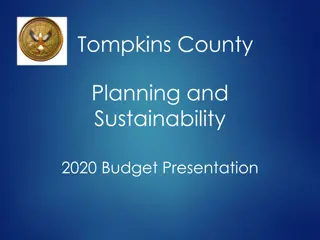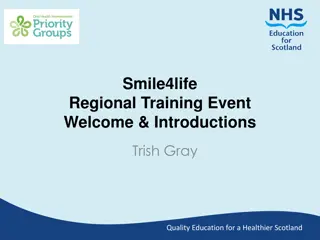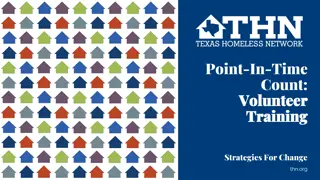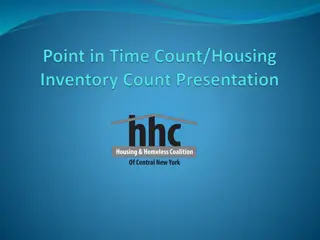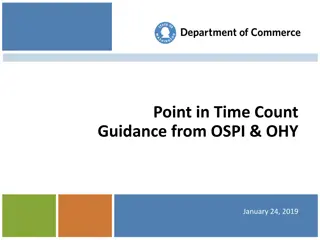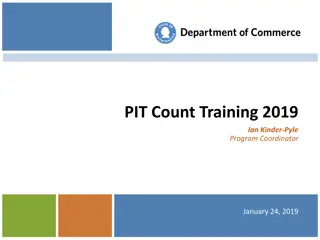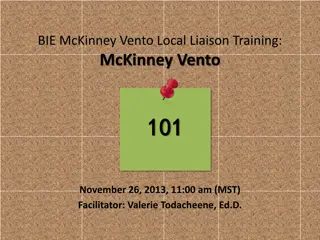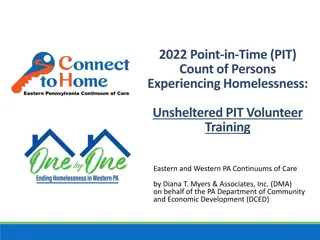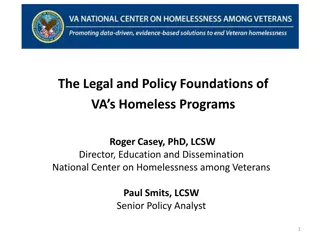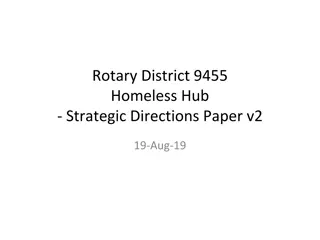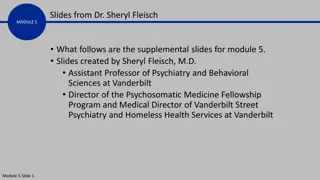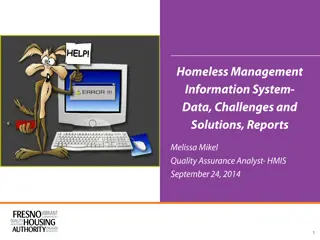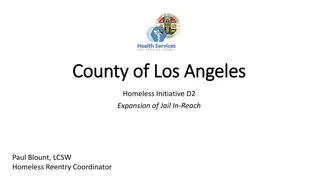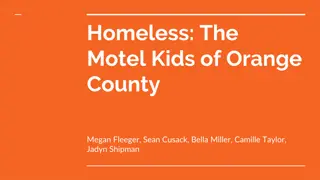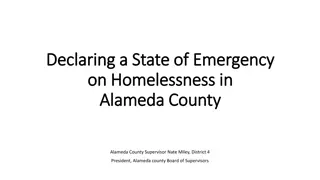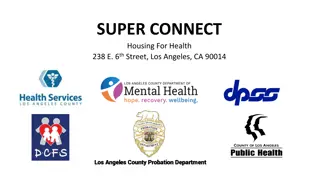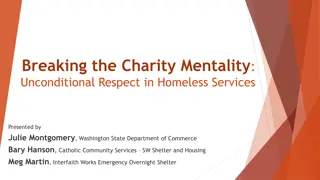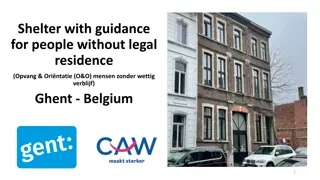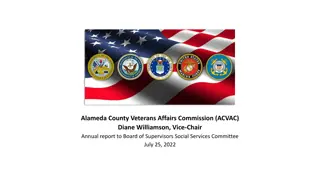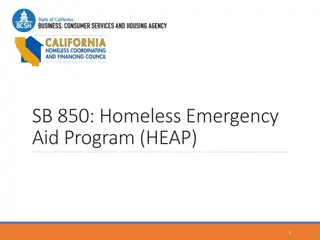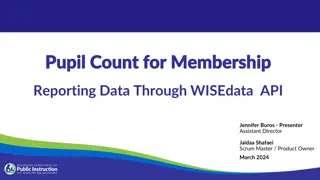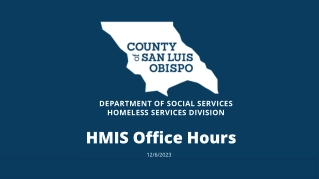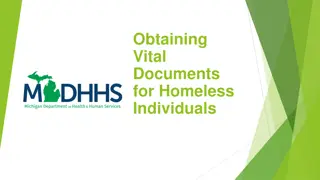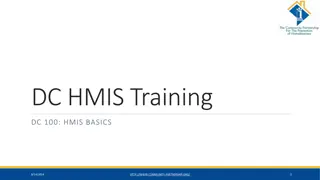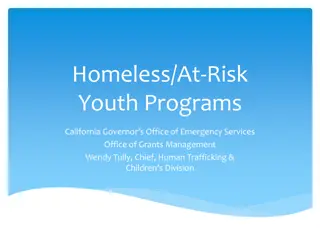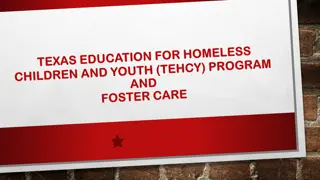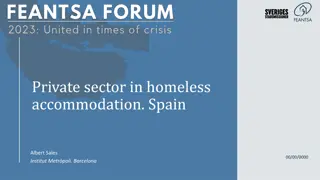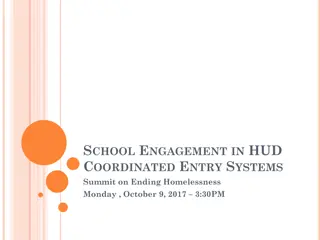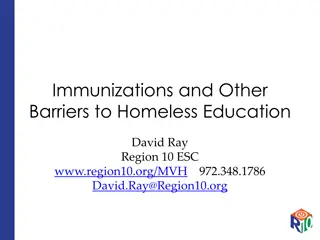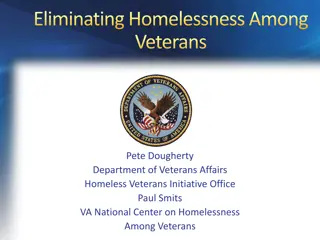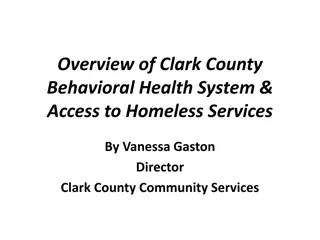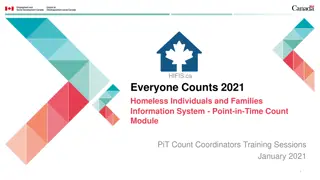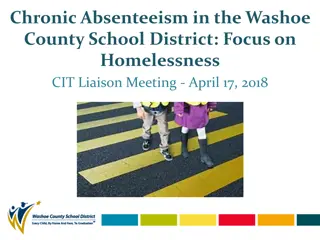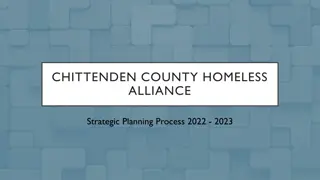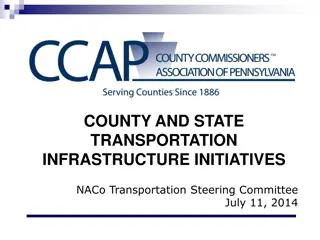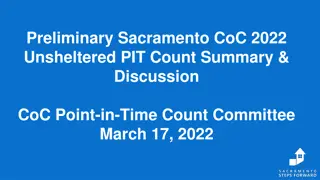Overview of Homeless Point-in-Time Count in Tompkins County
Homeless Point-in-Time (PIT) Count in Tompkins County provides a snapshot of the homeless population within a 24-hour period, including those in emergency shelters, transitional housing, and unsheltered locations. It is conducted annually to gather data on the number and demographics of homeless individuals and families, special populations, and validate information in the Homeless Management Information System (HMIS). The collection process involves outreach, surveys, and coordination with service providers and community members. Updates to the unsheltered count process include increased involvement from law enforcement, youth service providers, and community training initiatives.
Download Presentation

Please find below an Image/Link to download the presentation.
The content on the website is provided AS IS for your information and personal use only. It may not be sold, licensed, or shared on other websites without obtaining consent from the author. Download presentation by click this link. If you encounter any issues during the download, it is possible that the publisher has removed the file from their server.
E N D
Presentation Transcript
What is the Homeless Point-in-Time Count? The Homeless Point-in-Time (PIT) Count is a snap shot of the Tompkins County s Homeless population during a designated 24 Hr period. The PIT Count includes a census of homeless persons in the emergency shelter, transitional housing and unsheltered
Why do we do a PIT Count? A PIT count is required at a minimum of every year by HUD for communities receiving funding through the Continuum of Care. The PIT Count provides the CoC with the opportunity to take an annual snapshot of the number of homeless persons in the winter. The PIT Count also serves as an opportunity to cross check and validate the quality of data maintained in the Homeless Management Information System (HMIS) Outreach
What kind of information do we gather during the PIT Count? The number of current homeless persons in the county and the location they are staying. The number of homeless individuals and the number of homeless families. The number of homeless persons designated in special populations e.g. chronically homeless, severally mentally ill etc.
How did we collect this information for the PIT Count? First, we designated the 24-hour time period during which the PIT Count will take place. This year it was from 7PM January 23, 2017 to 7 AM January 24, 2017. For the Emergency Shelter and Transitional Housing we sent a census chart requesting names of individuals and families staying there that day along with demographic information.
How did we collect this information for the PIT Count? For the Unsheltered, an outreach group of local service providers and community members went to likely places individuals might be staying like interviewed individuals to find out their housing status. We also sent out surveys to various agencies around the county that could be completed within one week of the PIT Count Date. We collected data about the Literally Homeless, Imminently Homeless and Unstably Housed.
Updates to Unsheltered Count process Increased involvement from Law Enforcement JR Increased involvement from Youth Service providers Juliana/ Nick Development of training manual for ride-alongs Tierra Training of all community members involved in ride alongs JR/ Tierra Increased outreach and incentives (safety kits) - Rich Utilization of current homeless street outreach workers Tammy, Peter, Carmen, Chuck, Mike, Eric
Homeless Definitions Literally Homeless: Living in a place not meant for habitation, e.g. car, abandoned building, laundromat Imminently Homeless: eviction <= 14 days Unstably Housed (Couch Surfing): two or more moves in less than 60 days
Street-Survey Count 60 50 40 2015 2016 2017 30 20 10 0 Unsheltered Imminent Homelessness Unstably Housed TOTAL
Changes in PIT Survey Counts The decrease in the number of unsheltered literally homeless (2016 & 2017) are likely due to: change in cwp. The decreases in the number of imminently homeless and unstably housed persons are likely due to: decrease in feedback from programs.
Emergency Shelter 60 50 40 30 2015 2016 2017 20 10 0 Rescue Mission Advocacy Center DSS Total ES
ES Household Composition 30 25 20 15 2015 2016 2017 10 5 0 Persons in Families w/Children Individuals UnAcc Youth <18
Changes in Emergency Shelter Counts The decrease in the number of persons in the Rescue Mission Emergency Shelter were most likely due to? The decrease in number of persons housed by DSS in motels reflects: changes in systems. Increase in Advocacy Center reflects normal fluctuations.
Transitional Housing 25 20 15 2015 2016 2017 10 5 0 Learning Web TCAction CCTT Total TH
TH Household Composition 16 14 12 10 2015 8 2016 2017 6 4 2 0 Persons in Families Individuals UnAcc Youth <18
Changes in Transitional Housing The total number of persons living in transitional housing has remained the same over the past two years.. The decrease in the number of persons in families in TH reflects that TCAction is discontinuing the transitional housing program for families. Hence, no new families are being housed in this program. The increase in the number of individuals in The reflects the addition of four new beds through CCTT: A Place to Stay.
Total Homeless Counts 120 100 80 2015 2016 2017 60 40 20 0 HUD PIT Homeless ALL Homeless
Changes in Total Number of Homeless Persons For the PIT Count, HUD only counts those persons who are literally homeless (unsheltered + sheltered). There was an overall decrease of 16 homeless persons. This reflects decreases of number of persons identified in the street count as well as decreases in the number of persons housed in emergency shelter (RM & DSS). For the community PIT Count which also includes persons that are imminently homeless and unstably housed, there was an overall decrease of 32 homeless persons. This reflects decreases discussed above as well as decreases in imminently homeless and unstably housed.
Homeless Youth HUD has the goal of specifically counting homeless youth as this has been a population identified as having unique needs. Hence, we gathered information on literally homeless persons in different ages groups. < 18 yo (includes children in families) >=18 yo and <= 24 yo > 24 yo
Homeless Youth 70 60 50 40 2015 2016 2017 30 20 10 0 < 18 >=18 AND <=24 >=24
Homeless Youth The number of homeless persons <18 y.o. has remained low for the past two years reflecting decrease in the number of homeless families. The number of youth 18-24 has remained relatively unchanged over the past three years.
Special Populations As part of the PIT Count we gather information of special populations including persons with severe mental health, chronic substance abuse, veterans, victims of domestic violence and chronically homeless. Chronically Homeless defined a persons with a disability who has been literally homeless >1 year or experienced 4 episodes of literal homelessness in the past 3 years
Sheltered Special Populations 14 12 10 8 2015 2016 2017 6 4 2 0 Chronic Substance Abuse Severe Mental Health Chronically Homeless Veteran
Changes in Sheltered Special Populations This year there were no sheltered persons identified as chronically homeless (according to HUD definition). Changes in number of persons with SA and MH likely reflect normal fluctations.
Unsheltered Special Populations 12 10 8 6 2015 2016 2017 4 2 0 Chronic Substance Abuse Severe Mental Health Chronically Homeless Veteran
Changes in Unsheltered Special Populations The number of unsheltered persons with chronic mental illness has increased There was an increase in number of unsheltered chronically homeless (similar to 2015).
Summary of PIT Results There was decrease in number of persons using emergency shelter. There continues to be a lower number of homeless families compared to 2015. There was a slight increase in the number of persons age 18-24 largely reflecting increase funding and capacity of the Learning Web transitional housing program.
Summary of PIT Results The number of sheltered persons with severe mental health increased significantly. The majority of these persons were housed at the Rescue Mission. The number of unsheltered persons chronic substance abuse stayed the same. Summing across all categories there was a decrease in the number of all homeless persons for both of HUD PIT homeless count and CoC homeless count..


